| G | Player Pics | A-Z of Players |
Personal
Fullname: Peter Goldie
Born: 7 June 1934
Birthplace: Dumbarton
Signed: 9 May 1953
Left: 1958 (free); 13 June 1958 (to Aldershot)
Position: Defender, Full-Back, Half-Back
Debut: Celtic 5-1 Partick Thistle, League, 17 Dec 1955
Internationals: none
Biog
| “My main memories of my time at Celtic are of some fabulous team-mates.” Peter Goldie (2018) |

He would have to wait until 17th December 1955 before he finally made his first team debut at left-back in a 5-1 home league win over Partick Thistle, taking over from Frank Meechan. The Evening Times newspaper report stated as a compliment that Peter Goldie’s performance was such that he “was not misplaced” with his selection in the side, but cautioned that:
“Young Goldie had a considerable debut, but he too, will find stronger opposition”.
He played much of his football at Parkhead at right-half but after a sustained period out of the first team picture he couldn’t make his way back as a regular.
His spell of games came just after Celtic’s only real purple patch during the decade having won the league & cup double in 1953-54, and so missed out on the silverware.
He was mostly used as a fill-in for Sean Fallon, so no easy matter to try to replace the much admired man who was to go on to be rated as a Celtic great. Quite a proud accolade to have to act as his deputy.
Peter Goldie’s games were mostly in 1955-56, with a few games in the later seasons until he left in 1958. He was to play in the 1956 Scottish Cup final, being notified of this on the prior Thursday, only to find out on the day of the game that he was being dropped, and there were no subs then in those days to even allow him at least that consolation place. He watched the match in the stands with his family. Celtic lost the match 3-1 to Hearts. Curiously his name was even listed as being to play in the starting eleven in the match program.
His final game for the First Team was in a 1-0 win over Aberdeen away at the tail-end of the 1956-57 season, filling in again for Sean Fallon, but always shifting around to accommodate the stalwarts.
In his match time in season 1955-56, he had not played in a losing Celtic side but then only to see Celtic lose in his last three matches. Celtic were already well out the league race to the title, and these last results made no material difference overall.
It wasn’t to be for Peter Goldie at a weary Celtic, but he made a respectable 14 first team Celtic appearances.
One interesting historical honour, in retrospect, for Peter Goldie is playing against the ill-fated Busby Babes who perished in the Munch Air disaster in a 2-2 draw in a friendly in 1956, for a charity match for Cheshire Homes. Peter Goldie played against the great Duncan Edwards and had to mark him. It was just a week before the aforementioned 1956 Scottish Cup final.
He was released in the summer of 1958 and went on to sign for Aldershot. As Celtic were abject and were to enter a very barren spell from around the time of his departure until Jock Stein arrived as manager, maybe for his own sake he was best to be away to avoid some of the frustrating lows to come over the following years. One of his last matches at Celtic was a pre-season match between the reserves and the First Team, where he played alongside a spritely young lad who was to make a great name for himself: Billy McNeill.
At Aldershot, he was a part-timer and worked in the aircraft establishment at Farnbrough.
Peter Goldie later taught at St. Patrick’s High School in Dumbarton from around early 1970’s till retirement, where he was to be a good & successful manager for the school football team. At ‘St Pat’s’ he was a teacher alongside another ex-Celt, John Divers.
He was, regardless of the frustrating time at Celtic as a player, a Celtic man through and through and continued to follow Celtic both at home & away, which is something great to look back on. He kept links with the club, and Jock Stein on a request by Peter Goldie came over to help make a presentation to his son’s side who had won a junior Scottish Cup title. It was to be just a month or two before what was to sadly be Jock Stein’s untimely death.
Playing Career
| APPEARANCES | LEAGUE | SCOTTISH CUP | LEAGUE CUP | EUROPE | TOTAL |
| 1953-58 | 13 | 1 | 0 | 0 | 14 |
| Goals: | 0 | 0 | 0 | 0 | 0 |
Honours with Celtic
none
Pictures
Articles
The St Patrick’s school team that no-one could beat
Updated16:33, 25 Oct 2013 By Dailyrecord.co.uk
http://www.dailyrecord.co.uk/sport/local-sport/st-patricks-school-team-no-one-2537035
The sad death in Indonesia earlier this month of former Celtic goalkeeper Bernard McCready has brought back memories for many people.
The former Dumbarton man was deputy to Dick Beattie and Johnny Bonner at Parkhead, and played for St Patrick’s High School when they had one of their finest teams ever – and they had many.
Evidence of this is contained in the autobiography of Manchester United manager Sir Alex Ferguson, who boasted about the achievements of his school team, Govan High.
He adds that the only team they could not beat was St Patrick’s High School in Dumbarton, whose reputation was second to none.
One of Bernard’s team mates in the 1950s, Professor Johnny Walker, who now lives in Canada, sent in a photograph of one of the best St Patrick’s teams ever to play on the Rockies. Older readers will recall the notorious sloping football pitch in the school grounds at Castlehill.
Professor Walker, who later played for Renton Guild and Vale of Leven Juniors, recalled the team he played in, which also included another Celtic player from Dumbarton, Peter Goldie.
He said the first game of the two-leg Scottish Schools final against St Mary’s, from Bathgate, was drawn 0-0 in Dumbarton and St Patrick’s won the second leg 3-0.
The professor said: “St Mary’s star player was Vince Halpin who went on to play for Hibernian, but Peter Goldie had a tremendous game and played Halpin off the park.”
Professor Walker’s memories of Dumbarton football in the 1950s are fascinating. He was one of three St Patrick’s players who were ‘Sons daft’ in that era. The two others were Jim McAllister and Tony McGinley.
His football potential was spotted by Peter McCann, father of Dumbarton barber John McCann, who scouted for Vale Juniors.
Among the players he played with were St Pat’s boys Jimmy Moran and many of the Vale’s Scottish Cup-winning team as well as Christy Joyce, who later played for Notts County.
Other St Pat’s players who went on to big things included Pat Ward (Hibs and Leicester), John Heaney (Dumbarton and Bury), Mick Earley (Watford), Sammy Docherty (QPR), Hughie Rainey (Portsmouth) and Jim Mulkerrin (Hibs and Accrington Stanley). Other great players in the 1950s were Stan Mitchell, Paddy Carr and Gerry Donnachie – then there was Tim Whalen and Hughie Gallagher, both of Dumbarton, and Gallagher’s brother Jim, of Hamilton Accies.
PETER GOLDIE INTERVIEW
Posted by St Anthony | May 28, 2020 | Season 2019-2020 | 0 |
PETER GOLDIE INTERVIEW
Peter Goldie played for Celtic from 1953 to 1958. In this interview with St Anthony he gives a fascinating inside into how life was like for Celtic player in the 1950’s, how the club was run, and recalls some of the great players of the period. Peter is pictured above (back row, far left) in Celtic’s famous shamrock strip, before a home game against Kilmarnock, just seven days after they defeated Rangers 7-1 in the legendary League Cup final at Hampden.
* * * * * * * * * *
What’s your first memory of Celtic as a boy?
The first memory I have of being at Celtic Park as a boy, I actually wasn’t supporting Celtic, but my home town team Dumbarton given my family’s house was a stone’s throw from Boghead. My Dad took me up to Parkhead for this game which I believe was a Southern League fixture in September 1943 and I think Dumbarton won 4-1. Dumbarton had a great inside left then called Willie Reid who scored that day and went onto manage St Mirren. My Dad also used to watch the Vale Juniors as he came from Alexandria, but years later he came to some Celtic games with me. I was with him at Firhill in 1969 when very sadly he died just inside the ground. That was Tommy Callaghan’s first ever game for Celtic. I was a great admirer of big Jock, and when he became manager my brother John and I started following Celtic home and away for years, and hardly ever missed a game.
Did you have a favourite player?
In the very early 1950’s, I used to love watching big John McPhail. I remember seeing him when Celtic played Lazio. Celtic won and big ‘Hooky’ scored 2 or 3. John played anywhere. He could play right or left half, centre half, inside forward or as a centre forward and he scored some great goals. He scored the goal against Motherwell which gave us the cup in 1951. He was a nice big guy, and I was very fortunate to have been able to play several times with him in the reserves, and twice with his brother Billy in the first team.
How did you get to Celtic?
It’s like everything else, you just start playing as a boy with the school team and then the Boys Guild team. I played juvenile for Vale Emmett and then the junior side, Duntocher Hibs asked me to sign. In 1953 I was asked up to Parkhead to meet Jimmy McGrory for the first time and I signed for Celtic there and then. I got 6 shillings and six pence (about 32.5p) per game at Duntocher Hibs which was good pocket money just for playing football. Eventually at Celtic I was to get £7 a week playing in the reserves and £9 a week when I was in the first team, which wasn’t bad money for that time.
What was Celtic like at that time?
I was there five years although the first year I was only provisionally signed. Then for season 1954-55 I was called up although I was still serving my time as a draughtsman. When I first went there the trainer was George Paterson, who had played in the 1938 Empire Exhibition cup winning team. In the first year I would train one night a week as a provisional player and at the end of it you were given a cup of tea and a pie, but the players were charged sixpence for it. Eventually a few of the guys refused to pay, so this was stopped. I used to go up there then go home without having anything to eat or drink at all. But that was the way all clubs were back then; it was just the way it was.
You made your debut against Partick Thistle in 1955. What do you remember about that day?
My first two games were against Thistle and Hibs. I played against Thistle’s Johnny McKenzie who was their outside right and a Scottish international at the time. He was the nicest person ever. During the game I must have done something right for he came over to me and said ‘Well done Peter, keep it up son.’ This was during the game and you wouldn’t get that now. Next game I played was against the famous five at Easter road and Gordon Smith was outside right and I was left back against him.
What was your best position?
I was initially a right half with Duntocher before I got moved to right back to let the Duntocher captain, Willie Bone, play there. I was playing right back for Celtic and one day we were playing Rangers reserves at Parkhead. Willie Waddell was playing at outside left. He was nearing the end of his career although he was still playing for Scotland. I was having a good game against him so he moved across to outside right. I was quite confident and I asked Hughie Fletcher, who was our left back, to move over because I wanted to follow Waddell. I must have done okay then because they started playing me at left back and that’s where I made my debut.#
What was it like at Celtic in those days?
The ground was completely different from what it is today. There were no coverings on the terraces – no floodlights, only a 60 watt bulb at either end of the main stand, so when you went out to train at night it was pretty dark. I was 5 years there and never got a tracksuit or a pair of boots from the club. In those days the main boots were called Hotspurs, big heavy leather boots with what felt like steel toecaps. I only ever had one pair when I was younger, and you had to stand in a bath of water in your bare feet for hours to get them moulded to the shape of your feet. Just about that time a new boot was on the market, which we called continental boots, much lighter than the old hotspurs. Every year I always asked the boss, Mr. McGrory, for a pair of the new boots, but you only got a pair if you were in the first team.
When you went there at first you got a pair of spikes and a pair of sand-shoes. I kept the spikes and I still have them after all these years. We never called them trainers, we called them sand-shoes and you went out training with a baggy pair of shorts and a heavy jersey with a green number on it. When you went up to train, you sometimes found that either your sand-shoes were soaking wet as someone had been wearing them during the day, or there were no laces in them. You just had to take the laces out of your shoes and use them. In my 2nd year I was called up as a Celtic player, and went up to the park to train three nights a week under George Paterson. He was a really good trainer. I don’t know what happened, but George suddenly left and we didn’t have a trainer at all. I was very disappointed about this, but we still went in there three nights a week with no supervision, and we obviously became not as fit as we should have been. On a really cold night most of the guys went into the jungle and stood for a good while having a right good blether. We only moved onto the track when we could see old Jimmy Gribben coming down the tunnel to see how we were getting on.
But the first team were different. They trained during the day, but I’m still not sure who took the training. During my time there, we had 2 trainers, Alec Dowdells and Willie Johnstone. Alec was also the Scotland team trainer, but left during my time to go to England while Willie was there when we beat Rangers 7-1. They were called trainers, but you would not class them as that today, as neither of them were out on the park very much, nor took any training sessions. I would say that they were really physios, who treated the players for any injuries they might have, but again they were really nice people.
What kind of man was Jimmy McGrory ?
The nicest man you’ll ever meet. But you’ve heard other people say he wasn’t a strong person though he must have been a fabulous player. He was a very gentle person. But in those days there wasn’t any team talks or anything like that. He never came out on the park, but most times you would see him in his suit smoking his pipe.
What kind of influence was Bob Kelly?
I liked Bob Kelly although I didn’t have a great deal to do with him. He was the head man. Mr.Kelly was strict but he was straight to the point. We were just young guys but we knew something wasn’t right the way the club was being run.
How did you find the experienced players ?
The senior players were very good, always willing to help the young players as much as they could. My second game was against Hibs, with their famous five of Smith, Johnstone Reilly, Turnbull and Ormond, although I think Bobby Combe was at inside right that day when we won 3-2. In the first half, I passed the ball to Neilly Mochan, who raced up the park and scored a fantastic goal against Tommy Younger, the Hibs goalie. I turned round and big Jock Stein was coming across to me with his arms outstretched. He shook my hand very visibly to show the supporters that I, as a young player had done something to help in the scoring of the goal.
I had broken my leg and one day Mr. McGrory asked me to come up to the park during the day. I had a friend who wasn’t working so I asked him if he fancied coming up with me. When I got there the boss said we could get a taxi to Ferrari’s restaurant in Glasgow for a meal, which is where Celtic players went after training in the mornings. So the two of us went and it was fabulous. They were all there, Charlie Tully, Bobby Evans, Bobby Collins, Bertie Peacock, John McPhail, all the ones we idolised. We were sitting at a table at the side when big Jock came across, introduced himself, sat beside us, had his lunch with us and talked the whole time. What an experience.
Could you see something in Jock?
I only played three times with him in the first team and a few times in the reserves. He always had a demeanour about him, you knew you were in the presence of someone who was different. He was a terrific guy. I was a teacher in later years and in 1985 I was in charge of St Patrick’s U/13 school team when we won the Scottish Cup. Jock was Scotland manager at the time and I contacted him after all those years to ask if he would come to the school to present medals. He happily came down and spent the whole night with us. Unfortunately he was to die a couple of months later in Wales at a Scotland Match.
What were the players like?
Bobby Evans was perpetual motion. He was a super right half. Bobby Collins was a fabulous player as was Bertie Peacock. Charlie Tully was always full of fun when you saw him. He wasn’t the best of trainers, but he was a fabulous entertainer on the park, and was idolised by the support. He used to wander around the dressing room singing hymns before the games. He was different. But all the main players were very good to the younger guys like myself. In those days there were no tactics or anything like that, no one said anything before we went out, that’s just the way things were. I played against Johnny McKenzie and Gordon Smith in my first two games and no one gave me any guide as how to play them. On a Thursday night after training the team sheets for the first and second teams were put up so you knew then which team you were in. On the day of the match there was no warm up. You went into the dressing room, got stripped, and had a rub-down on the treatment table from one of the players who wasn’t playing that day. I remember giving the likes of Charlie Tully a rub-down before a game, while also getting the same treatment from Bobby Collins when I was playing. A couple of minutes before the game the teams went out onto the park, the players would do a couple of sprints, then it was straight into the kick off. It was so naïve compared to today.
Celtic played Hearts in the 1956 Scottish Cup final and you were due to play?
On the Thursday night after training, Alex Dowdells asked me, ‘How would you feel playing against Jimmy Wardhaugh?’ and then he told me I was down to play. On the Saturday, my mother’s cousin’s son, who had just been ordained and was saying his first Mass in St Michael’s, Dumbarton. All the family were there for the 9am Mass, before we went to his father’s house for tea. I then left to get a bus home to get changed, then another bus to Glasgow to meet the players in Ferrari’s. My family thought I was playing and my name was actually printed in the match programme. Mr. McGrory read out the team in Ferrari’s and I wasn’t in it. My father and my brothers were all there and only knew I wasn’t playing when the team was read out at Hampden. I never received any explanation about it. Looking back, despite being very disappointed, I don’t think I would have picked myself at right half, the position I was supposed to play, ahead of Eric Smith, who did play there and who was a really good player.
You played for Celtic against Manchester United’s Busby Babes?
That was a midweek friendly. I was right half in direct opposition to Duncan Edwards at left half. He was just a young guy but he was a fabulous player and he tragically died in the air crash. That game was played on the Tuesday night before the Hearts cup final. Afterwards we went to the St Enoch hotel and Matt Busby presented every player with a memento of the occasion.
Were you at the club when we beat Rangers 7-1?
Yes I was. Bertie Auld still moans about that game as he played every game up until the final and yet never played in it. There were no subs back then, so we were down in Dumfries with the reserves, Bertie and all, playing Queen of the South and we hadn’t a clue about the score until someone came on to the bus and said, ‘God, Celtic beat Rangers 7-1!’ The next week Celtic played Third Lanark at Cathkin and John Donnelly, who was the right back, had the flu, so I was called in to replace him. The following week we beat Kilmarnock 4-0, the first home game after the 7-1 final, when we wore the famous shamrock strip. That was to be my last game for the first team.
If John Donnelly had taken the flu seven days earlier then you might have been in the 7-1 team?
Well you don’t know. But I played the next two games after it. When I was pictured in the team group, after the 7-1 game, against Kilmarnock I was pretty embarrassed about it. I knew I hadn’t played in the cup team and felt I shouldn’t have been in the photo. But I’m in there and my son, Peter, has that picture. I got the whole team, and several other players, including big Jock, to sign the picture. Peter is Celtic daft and travels all over Europe to watch Celtic, and comes up from Manchester for most home games on the Preston Emerald Bus.
Was there any one game for you which stands out?
I played against Morton at Cappielow in the Scottish Cup when I got a good report which said. ‘The best defender on the pitch was young Peter Goldie’ and another game the Monday after the Hearts cup final, we played Thistle at Firhill and although we lost 2-0 I had another good game. You remember the games you played well in. I was mainly a reserve team player and I captained the reserves for about a year. There were a lot of good players in the reserves and any first team player coming back from injury would play in the reserves.
Did you ever play with a young Billy McNeill?
I am proud to say that I played a trial game with big Billy. My last year was 1957-58 and the provisional signings that year were Billy McNeill, Charlie Gallagher and Pat Crerand. They used to have a game between the first and the reserve team in what they called a ‘trial game’ at Parkhead. A big crowd would always come to see it. Billy played for the reserve team and you could see right away that he had something special, being able to leap a tremendous height, and clearing everything in the air. I got to know him very well over the years. He is sadly missed.
There’s another Celtic connection?
Evan Williams ran about with one of my younger brothers, Maurice. He used to come to our house as a boy. A few years back Celtic gave him a presentation night at Parkhead and he asked me to be one of his guests. This was about five years ago. He said that my Mum used to feed him and then I would take him home, to Brucehill, the other side of Dumbarton from where we lived. When his mother asked where he had been Evan would say ‘The Goldie’s and his Mum would say ‘Well, you’ll not need fed then.’ Stevie Woods, the Celtic goalie coach is also connected to our family. His mother in law and I are full cousins, while his father was also my late wife’s cousin.
What memories do you look back on fondly?
Just the fact I played for Celtic, and that I got to play with the likes of Bertie Auld, Mick Jackson, Mike Conroy, Alec Byrne, Jimmy Rowan who were mainly reserve team players at that time, and all the other top players I played with during my time there. Sadly, too many of them are no longer with us. Looking back, at least I can say I played for Celtic and my family are very proud of that.
What about the current team?
I can’t watch the games live as I get too excited, so I have to tape the games to watch them afterwards ….if they win. This nine in row is brilliant, every bit as good as the last one, when I saw almost all of those games.
Thanks for taking the time to speak Peter.
My pleasure


When Peter Goldie met Billy Craig – Two Celtic stars reunited
By Matt Corr 3 June, 2023 No Comments
When Peter Goldie met Billy Craig – Two Celtic stars reunited
When Peter met Billy…a tale of two Celts reunited…
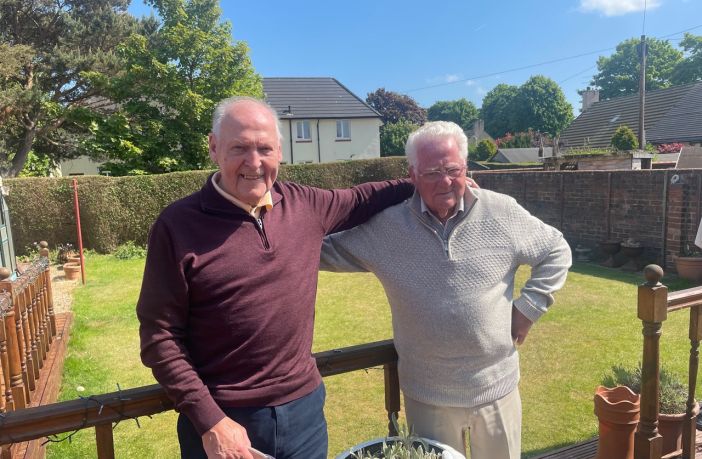
Spent the most enjoyable afternoon on Thursday in the company of two men who lived their dream…and ours…by pulling on those famous green and white Hoops to play alongside some of the greatest-ever Celts under Jimmy McGrory. Peter Goldie and Billy Craig were born within a few months of each other in 1934, and so will be entering their 89th year very shortly – in Peter’s case next week – but you would never know that as the two old pals meet up again for the first time in 66 years.
The stories, ‘patter’ and laughter flow as we roll back the decades to a very special time. With the Scottish Cup final this afternoon, I’m particularly interested in hearing their recollections of events around the 1956 showpiece, which pitched Celtic against Hearts and which I know produced bittersweet memories for both men.
First some context.
Peter Goldie was born in Dumbarton on 7 June 1934 and was an 18-year-old defender with junior outfit Duntocher Hibs when Jimmy McGrory offered him a provisional contract in May 1953, just 24 hours after the Celtic manager had brought Neil Mochan to the club from Middlesbrough in an £8,000 deal.
That fee would prove to be money well spent by the end of the month as Celts defied the odds and Hibernian’s Famous Five forward-line to win the Coronation Cup. Peter was amongst the 117,000 crowd who enjoyed that unexpected victory at Hampden, and indeed it was he who provided that wonderful photograph of Smiler’s shot flashing past Hibs keeper Tommy Younger to give Celtic a first-half lead. Peter would remain for a final campaign at Duntocher, suffering a broken leg in October of that year before recovering to be called up by Double-winners Celtic as the 1954/55 season kicked off.
First image I have of him wearing the famous Hoops was ahead of the match against Rangers at the opening of a new covered enclosure at Petershill Park in Springburn in August 1954.
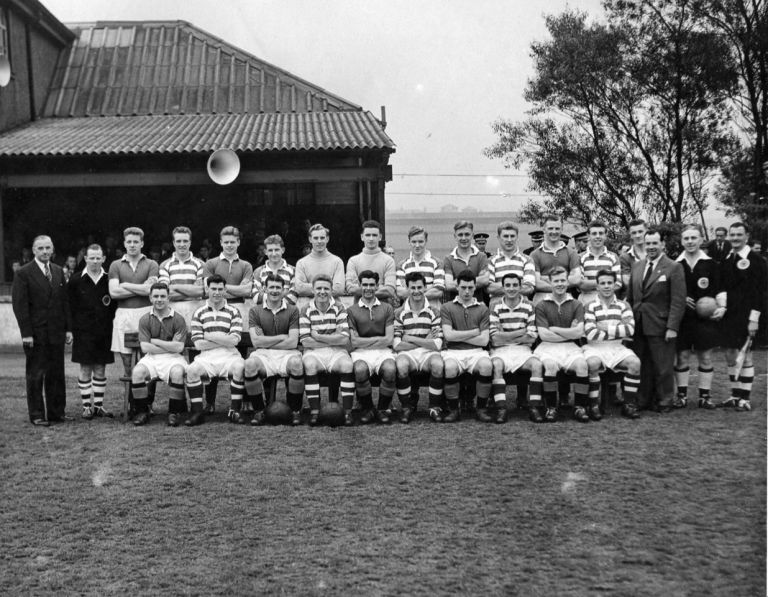
Photo of Peter Goldie at Petershill Park in August 1954. He is seated, second from left.
William Paul Craig was born in Shettleston in the shadow of Celtic Park on 1 November 1934 and was educated at St Joseph’s College in Dumfries, the final resting place of Brother Walfrid, where he built up a reputation as a fantastic sprinter.
Billy was playing with St Anthony’s when he was given a trial and signed provisionally by Celtic at the end of September 1953, the 18-year-old winger staying with the Govan junior side until the summer of 1955 when he received the call-up to senior football at Parkhead. He would meet Peter for the first time as the squad assembled for pre-season, both young hopefuls captured together in an iconic photo taken before the public trial match at Celtic Park in August 1955.
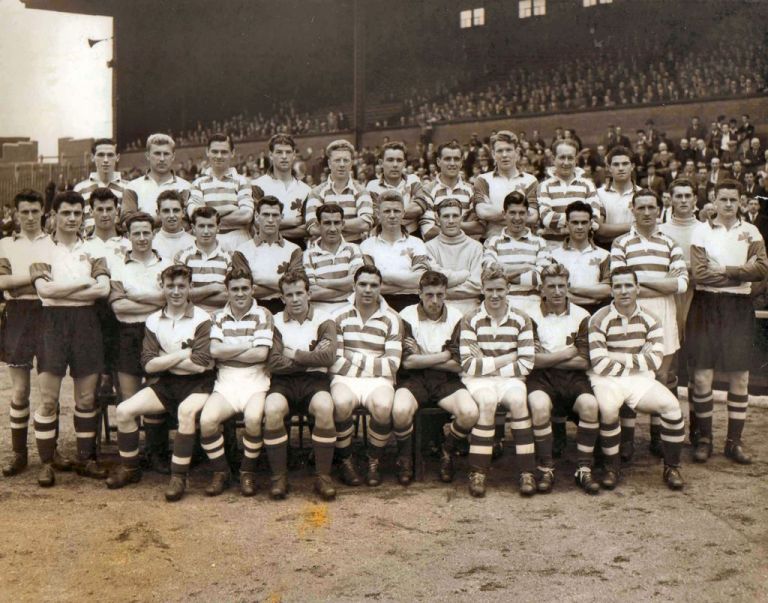
Celtic squad photo of August 1955. Both men are wearing the shamrock kit. Billy is fourth from left in middle row, with Peter another three along, next to Sean Fallon.
Billy would receive his first-team debut the following month, as Celts opened up their League campaign against Falkirk at Brockville on Saturday, 10 September 1955. Just seven days earlier a League Cup match between the sides at the same venue had been marred by trouble both on and off the pitch, the resulting fallout from that seeing many official Celtic supporters’ clubs boycott the League match.
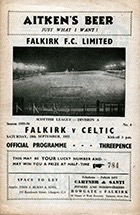
And the previous night, Celtic had defeated Partick Thistle 2-0 at Firhill to knock the holders out of the Glasgow Cup and set up a final with Rangers later that month. Unsurprisingly, Celtic made five changes from the Firhill line-up for the following afternoon’s match in Falkirk, the Hoops lining up on Billy’s big day as follows.
Dick Beattie, Mike Haughney & Frank Meechan; Bobby Evans, John Jack & Bertie Peacock; Billy Craig, Alex Boden, John McPhail, Eric Smith & Neil Mochan.
Neil Mochan opened the scoring for Celtic, but the Bairns would hit back to win 3-1. In an era of somewhat bizarre selection decisions at Parkhead, defender Alex Boden was Billy’s right-wing partner, the first but not the last time that would happen that season.
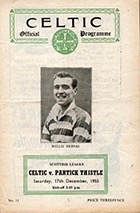
Peter made his senior debut three months later, replacing Frank Meechan at left-back for the visit of Partick Thistle on Saturday, 17 December 1955. This was the League game which saw Jock Stein make his comeback following four months out with an ankle injury and Neil Mochan score a hat-trick, including one directly from a corner kick, in a 5-1 win. The Celtic team that day was as follows.
Dick Beattie, Mike Haughney & Peter Goldie; Bobby Evans, Jock Stein & Bertie Peacock; John Higgins, Willie Fernie, Jim Sharkey, Bobby Collins & Neil Mochan.
Peter’s direct opponent that afternoon was Thistle’s dashing Scottish international winger, Johnny MacKenzie, the Celt recalling that the Highlander complimented him on some of his early work, “a real touch of class.” He must have played well, The Evening Times commenting that “Young Goldie had a considerable debut, but he too will find stronger opposition.”
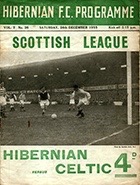
He wouldn’t have long to wait. Peter retained his place for the top of the table battle at Easter Road on Christmas Eve, his direct opponent this time being the legendary Hibernian winger Gordon Smith, as Celts won 3-2 to remain top of the League. Sean Fallon returned from injury to claim the left-back slot for the 5-3 Glasgow Cup final victory over Rangers on Boxing Day.
Speaking of Sean brings me nicely to the background of how this meeting came together.
Since the early part of last year, I have been working on a book covering Celtic in the 1930s, with the unmatched combination of triumphs and tragedies that involved. The main block of research and writing is now complete, and I am adding a few touches, one of which involved compiling a list of ‘future Celts’ who were born in that decade. I picked up on Billy, who was shown as being born in 1936, but cross-checking that it didn’t quite fit with the timeline.
I was aware that Billy had married Sean Fallon’s sister, so checked with Sean junior, a friend of mine from his time at Celtic FC Foundation. Sure enough, Sean confirmed with his Uncle Billy that his correct date of birth was 1 November 1934 and said he would be up for a chat about his time at Celtic. I’m also friendly with Peter and thought the gents might enjoy a wee catch-up together. A few phone calls and e-mails later, we have a lunch date at Billy’s Ayrshire home.
Peter and I are heading across the Erskine Bridge and I’m bombarding him with a thousand questions, one of which was around his favourite memory of his time at Celtic. Without hesitation, he says that was signing for his club all those years ago, then adds that the first-team players were always brilliant to the reserves. “They treated you so well, as equals. From conversations I had with players at other clubs, that wasn’t always the case.”
It’s clear that Peter was particularly fond of Jock Stein, and he reiterated a story he had shared with me previously, about that Christmas Eve game at Easter Road, mentioned above. “I was involved in one of the goals, and Jock made a point of coming over to congratulate me. It was his way of emphasising to the Celtic supporters that ‘the new guy’ had done well. It was a lovely touch and so typical of him. I never forgot that.”
Jock also featured in a more hair-raising anecdote, for those of you for whom that is a thing! We’re travelling at pace along the M8 when he recalls a trip to Easter Road back in the 1970s. “We travelled everywhere to follow Celtic once Jock became manager. Special times. One day we’re heading to Edinburgh, I think Celtic had the chance to win the title at Easter Road. Anyway, we’re driving along and next thing I hear the window of a passing bus being knocked loudly. I look across and there’s Big Billy McNeill, chapping and waving furiously to me. He’s then obviously shouted down to Jock that Peter Goldie’s in the car alongside the team bus, as next thing there’s Big Jock standing on the open steps of the bus, gesturing into us. He was so close he could have reached across and cleaned my wing mirrors! Crazy stuff.”
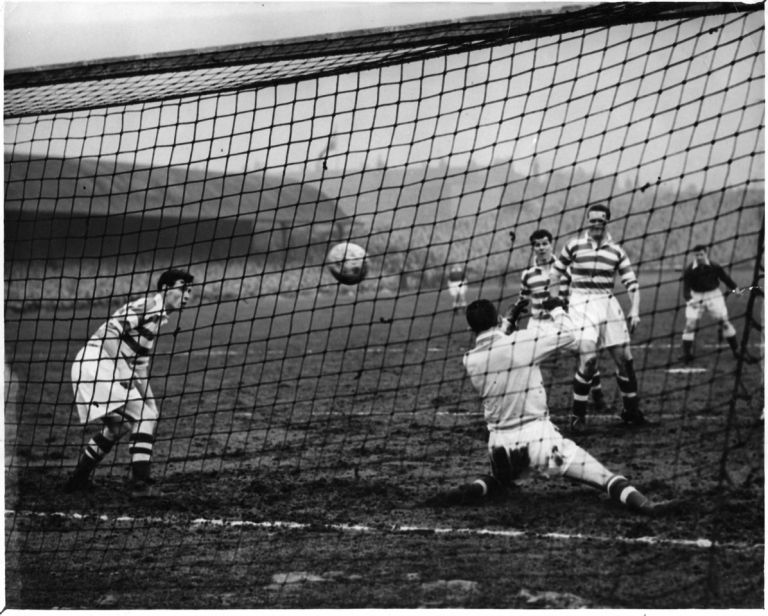
Peter Goldie and Jock Stein versus Hearts in January 1956
I asked Peter when he had last seen Billy Craig, and he thinks for a moment before coming up with “1958. Not since he left Celtic.” That actually makes it 1957, so the best part of seven decades ago. I feel like Cilla Black. This is going to be a bit special.
We pull up outside Billy’s home just before noon. He’s waiting at the window and I guess a thousand emotions are going through his head after so many years. I hang back to let the guys say their hello’s then follow them through to the back garden whilst Billy gets the kettle on. I’m expecting an emotional reunion, but the guys are hiding it well. Within minutes of sitting down the good-natured ‘banter’ is underway. “You were on £3 a week? Ya wee b*gg*r, I was only getting £2!” It’s a recurring theme throughout the afternoon, as the two ex-Celts hilariously compare notes from a period so far removed from today’s millionaire superstars.
I asked the lads if they recalled playing in the first team together, and there is a pause and a shaking of heads before smug little Swotty McSwot here produces the answer.
Peter and Billy played together four times competitively, the first of those being in a League match against St Mirren at Love Street on Wednesday, 28 March 1956. Four nights earlier, Celtic had taken a degree of revenge for their Scottish Cup final defeat by Clyde the previous season by beating the Bully Wee 2-1 at Hampden to qualify for a third successive final, this time against either Hearts or Raith Rovers. Peter and Billy would step in for injured duo Sean Fallon and Jimmy Walsh as the Celts won 2-0 at Paisley, thanks to goals from Bertie Peacock and Neil Mochan, on the night a young Tommy Bryceland made his St Mirren debut. Hearts beat Raith Rovers 3-0 in their semi-final replay the same evening to set up a clash with Celtic in the final. The Celtic side at Love Street that evening was as follows:
Dick Beattie, Mike Haughney & Peter Goldie; Alex Boden, Bobby Evans & Bertie Peacock; Billy Craig, Bobby Collins, Neil Mochan, Willie Fernie & Charlie Tully.
The duo appeared together again two weeks later, this time against defending champions and League Cup-holders Aberdeen at Celtic Park on Tuesday, 10 April 1956, Billy replacing the injured Bobby Collins at inside-right in the following line-up:
Dick Beattie, Mike Haughney & Sean Fallon; Peter Goldie, Bobby Evans & Bertie Peacock; John McAlindon, Billy Craig, Neil Mochan, Willie Fernie & Charlie Tully.
A disappointing match ended 1-1, John McAlindon having opened the scoring for Celtic early in the second half. Both Peter and Billy would miss out on the trip to Kilmarnock, played on the Friday night with the Scotland v England clash taking place at Hampden the following day. Eric Smith and Jim Sharkey got the nod to make their first-team returns in a goalless draw.
Peter and Billy then appeared together in a very special match on the Monday night before the Scottish Cup final, a 2-2 draw at Celtic Park with the ‘Busby Babes’ on 16 April. The newly-crowned English champions Manchester United were in Glasgow to play a charity fundraiser, the Hoops lining up as follows:
Dick Beattie, Mike Haughney & Frank Meechan, Peter Goldie, Bobby Evans & Bertie Peacock,
John Higgins, Jim Sharkey, Neil Mochan, Willie Fernie & Charlie Tully.
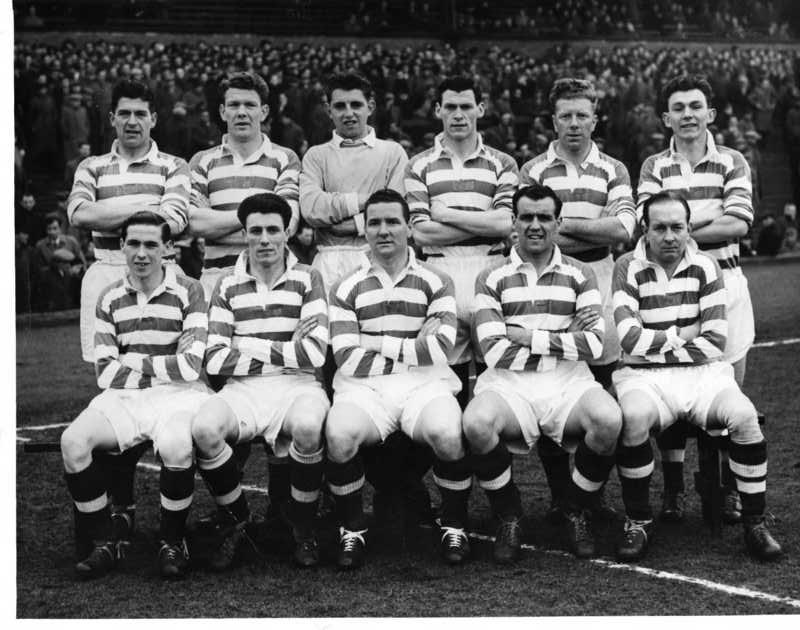
The Celtic team photo before the game against Manchester United
Peter’s direct opponent that evening was the powerful Duncan Edwards, considered the finest young talent in Britain, his physicality in the opening half bringing a warning from referee Jack Mowat. Celtic’s plans to use the match as a warm-up for the upcoming Scottish Cup final would be thrown into disarray by the interval, as Dick Beattie and Charlie Tully limped off to join Sean Fallon and Bobby Collins on the doubtful list for the big game.
John Bonnar and Billy Craig were the replacements, as Celtic’s 2-0 lead courtesy of Neil Mochan and a Mike Haughney penalty was cancelled out by headers from Albert Scanlon and John Doherty in the closing quarter of the match. Billy recalls making a challenge on Edwards which the Englishman did not take too kindly to, threatening “to break me in half next time.”
There would be the saddest of footnotes to that night. Within two years, six of that United team would perish in the aftermath of the tragic air crash at Munich Airport, captain Roger Byrne, the entire half-back line of Eddie Colman, Mark Jones and Edwards, plus forwards Tommy Taylor and David Pegg. First goalscorer Scanlon was one of three players from that evening who miraculously survived the crash, goalkeeper Ray Wood and striker Dennis Viollet being the others. More than 65 years later, the events of 6 February 1958 in Munich still bring a chill to the heart, United legend Bobby Charlton now the sole survivor of that tragedy.
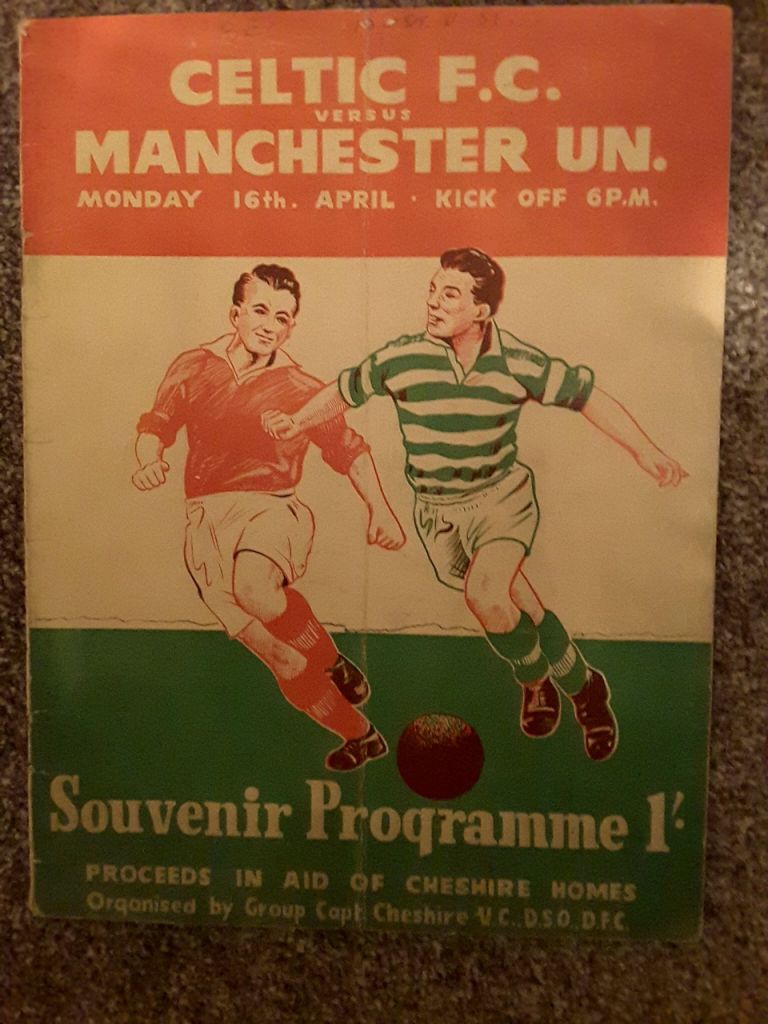
Both men recalled the highly unusual gift they received from that night, a bronze globe which opened out to reveal a beautiful clock. The plinth was engraved with their names and the date of the match, a treasured possession so many years down the line.
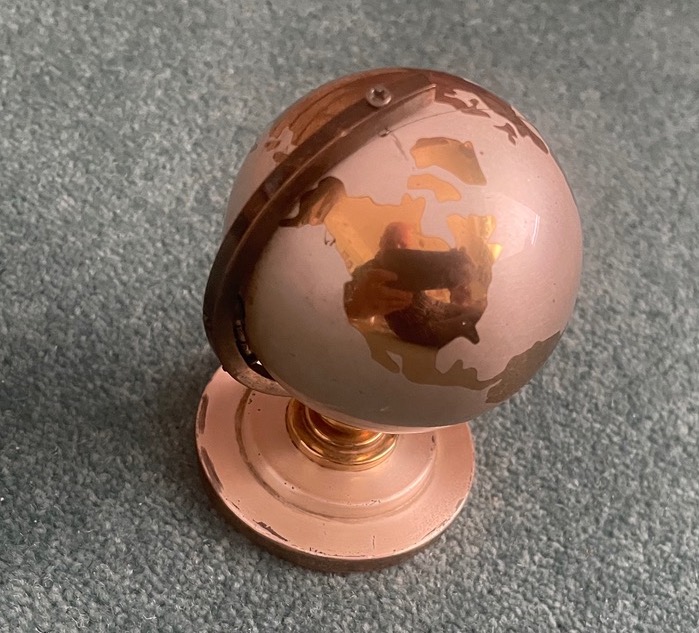
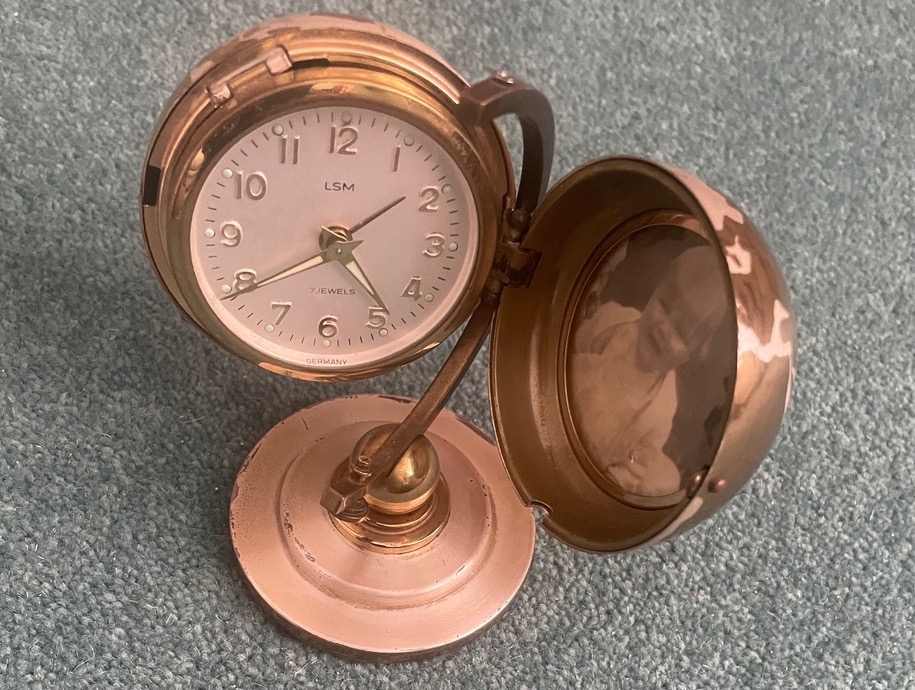
Two nights before the Scottish Cup final, Peter recalled that Parkhead trainer Alex Dowdells advised him that he was in the team for Hampden, and indeed his name was duly printed in the match programme as Celtic’s right-half.
Sadly, there was to be huge disappointment for the 21-year-old as the players enjoyed a pre-match lunch in Ferrari’s, a Glasgow restaurant, Eric Smith’s name on the team list pinned to the wall rather than Peter’s. No explanations were ever forthcoming.
One can only imagine his crushing disappointment as Peter sat in the stand with his family to watch his teammates go down 3-1 in front of 133,000 spectators, although a gentleman to the end, he says he would have chosen Smith ahead of himself in that position! Billy was included in the line-up, replacing the injured John Higgins, but another bizarre team selection saw left-back Frank Meechan picked at right-back, whilst the normal occupant of that slot, Mike Haughney, was listed at inside-right to partner Billy on that flank! It was yet another example of the haphazard management style of the era, which would cost Celtic a realistic chance of success.
Billy remembers it well.
“It was a warm, warm day at Hampden but there was no water, and my tongue was hanging out racing up and down that flank. We all expected Jim Sharkey to be playing at inside-right. He was a smashing player. Looking back, presumably Mike Haughney was stuck up front as he had a powerful shot, and perhaps the idea was that I would get to the line to pull the ball back for him to strike, but we didn’t really have any tactical discussions or explanations back then. You sort of just went out and got on with it. It was a difficult afternoon.”
For completeness, the Celtic team at Hampden on Saturday, 21 April 1956 was as follows.
Dick Beattie, Frank Meechan & Sean Fallon; Eric Smith, Bobby Evans & Bertie Peacock; Billy Craig, Mike Haughney Neil Mochan, Willie Fernie & Charlie Tully.
Billy did receive a pretty special memento from the day, though, a Scottish Cup medal which he brought out to show us. Humble to the end, he preferred not to be photographed with it.
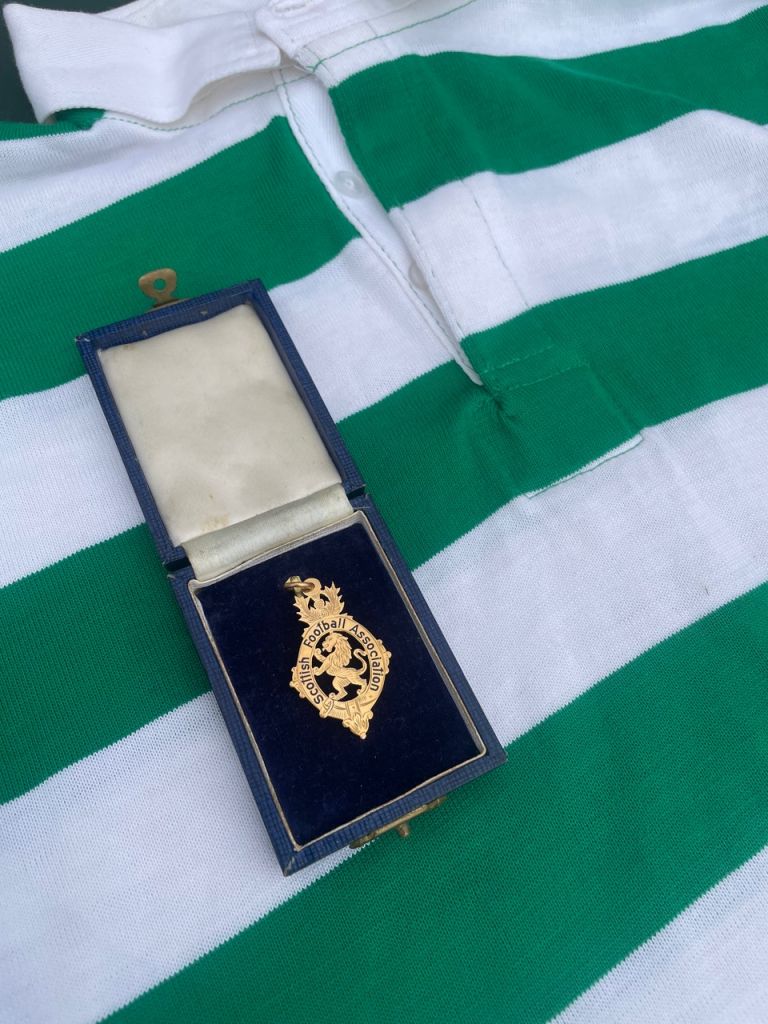
More than six decades on, Peter can at least see the funny side of it.
“At least I’m the subject of a good quiz question, as the only Celtic player to have his name printed in two cup final line-ups in the match programme without kicking a ball. The same thing happened for a Glasgow Cup final against Rangers, which I think we won 5-2 or 5-3.”
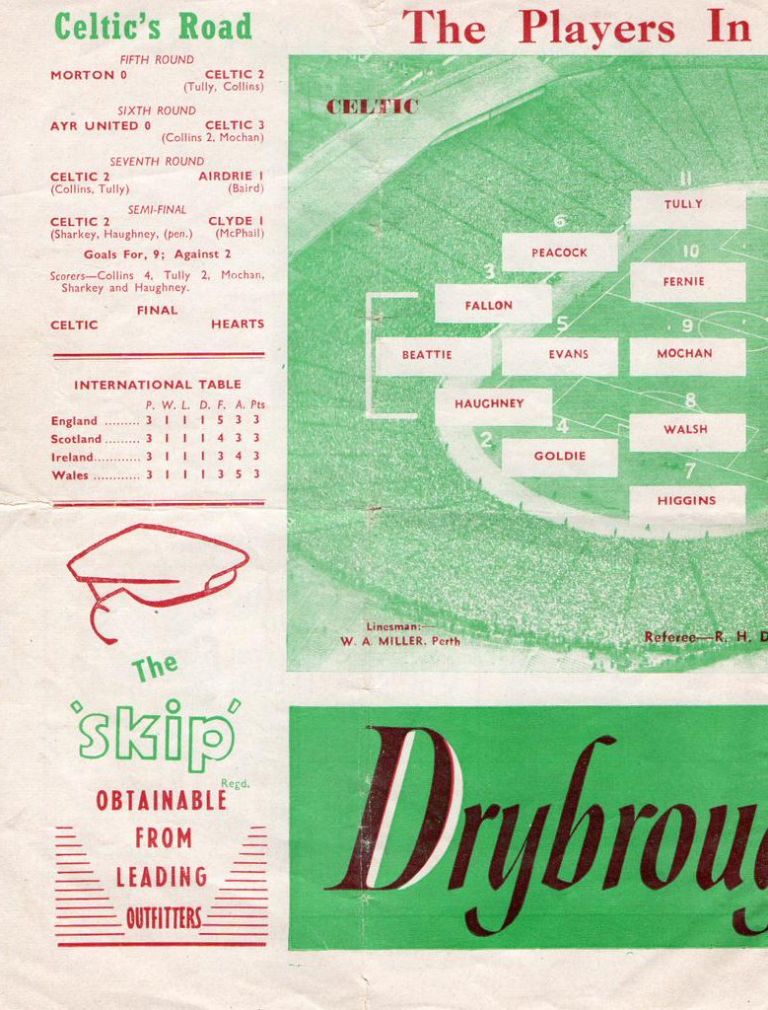
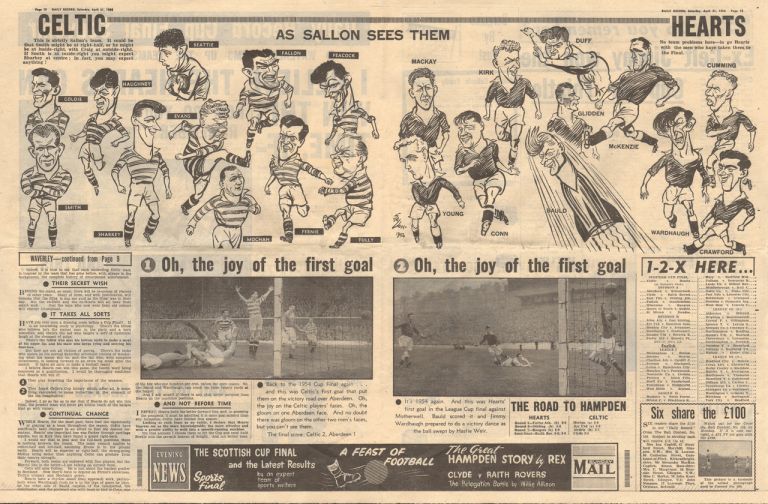
Photos of programme and cup final preview, both of which include Peter.
He would need that sense of humour, as to add insult to injury, Celtic’s visit to Firhill on League duty two nights later saw Mike Haughney restored to right-back, Eric Smith to inside-right and Peter at right-half! With Sean Fallon and Frank Meechan both hurt at Hampden, former Duntocher Hibs defender Jim Kennedy made his debut at left-back. Haughney sent a passback beyond his own keeper Dick Beattie six minutes from time for Thistle’s second goal in a 2-0 defeat, Peter’s first as a Celtic player in his ninth competitive game in the Hoops. The Celts team that night was as follows:
Dick Beattie, Mike Haughney & Jim Kennedy; Peter Goldie, Bobby Evans & Bertie Peacock;
Billy Craig, Eric Smith, Neil Mochan, Willie Fernie & Charlie Tully.
A League campaign which had earlier promised so much was concluded with a whimper 48 hours later. John Bonnar made his comeback from injury as Hibernian ensured they would finish above Celtic in the League table by winning 3-0 at Parkhead, ‘Last-minute Lawrie’ Reilly becoming one of the select group of players to net a hat-trick for a visiting team at the old ground. This would be the last time Peter and Billy appeared in a Celtic first-team together.
John Bonnar, Mike Haughney & Sean Fallon, Peter Goldie, Bobby Evans & Bertie Peacock,
Billy Craig, Willie Fernie, Jim Sharkey, Jimmy Walsh & Neil Mochan.
The 1956/57 campaign would be the last Peter and Billy would spend together at Celtic.
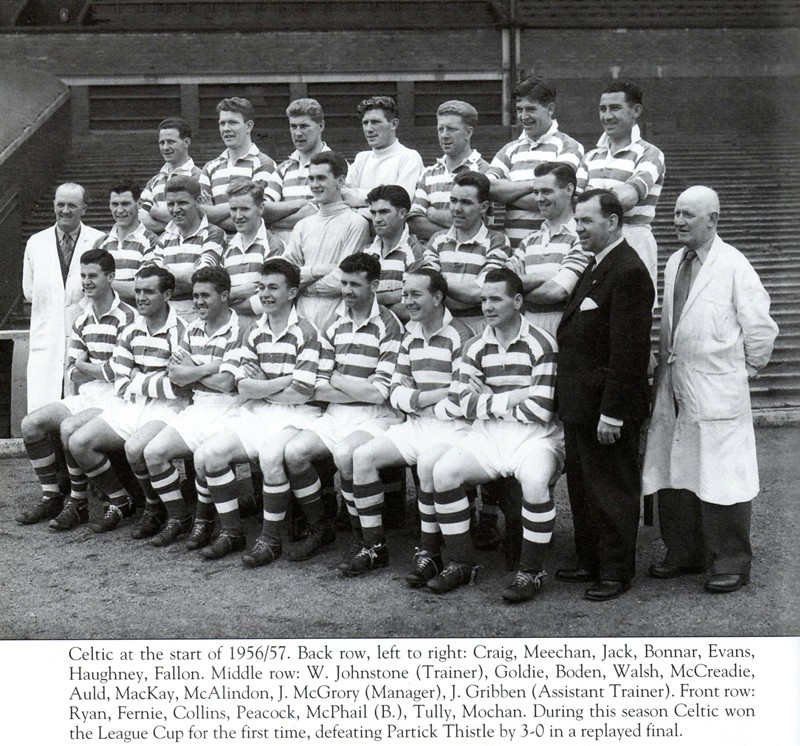
1956/57 Celtic squad photo. Billy is extreme left in back row, with Peter immediately in front of him, next to trainer Willie Johnstone.
Billy played just two matches, both in October, before being freed in April 1957. Two months earlier, he had taken teammate Sean Fallon to his sister Myra’s 21st birthday party, the subsequent introduction and romance ending with the marriage of the couple in 1959. By that time Billy had enjoyed a successful two-year spell with Third Lanark before joining Morton. He would end his senior career at Berwick Rangers before following in his father’s footsteps by becoming a bookmaker.
Billy produces a scrap book full of newspaper clippings, many of which cover his spell at Third Lanark. Any special memories from Cathkin?
“I was always blessed with great pace. I remember being up against Sammy Cox, who played for many years at Rangers then moved on to East Fife for a couple of seasons before ending up in Canada. He’s about 10 years older than me and I’m having a field day at Ibrox, running past him at will and I’m actually starting to feel sorry for Sammy when I hear a voice from crowd. “Haw, Craig, yer maw’s a nun!” I mean, what are you meant to do with that? I just burst out laughing.”
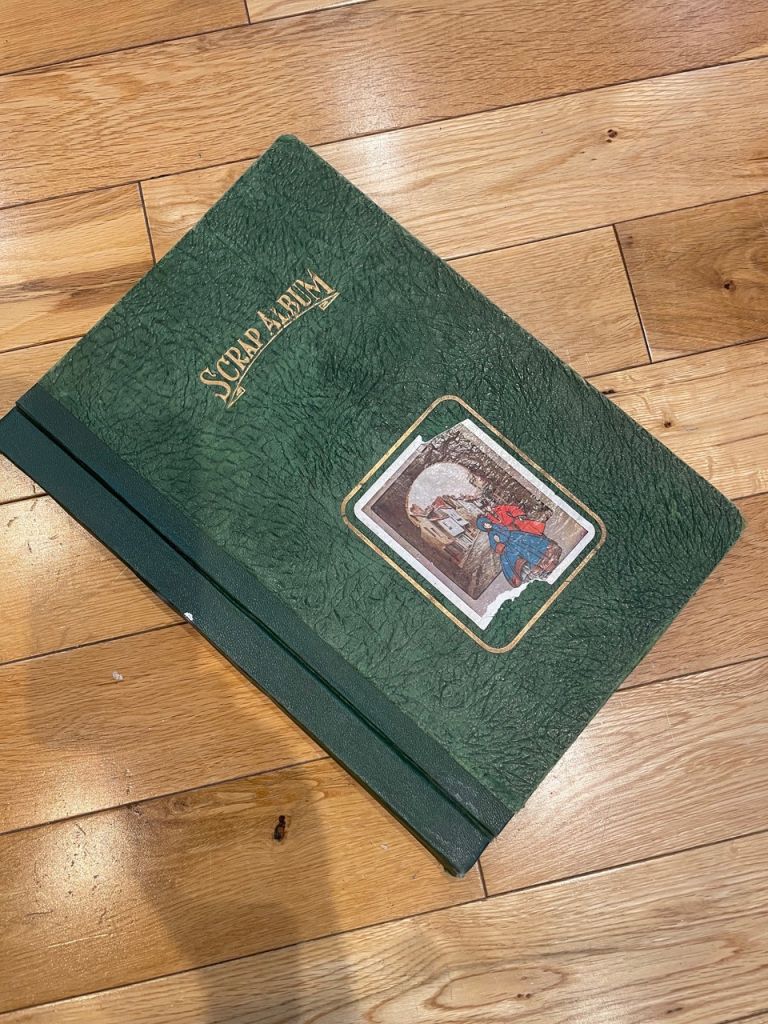
Peter would manage just one Celtic first-team appearance in 1956/57 then two the following campaign, the last of which saw him replace flu-victim John Donnelly and included in an iconic photo with the 10 other Celts from the 7-1 humiliation of Rangers in the League Cup final.
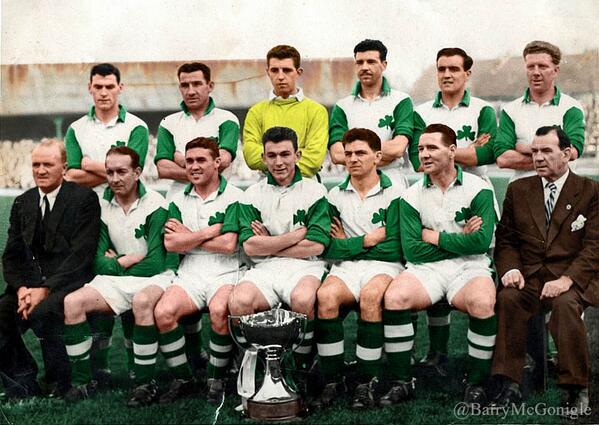
1957 League Cup final photo. Peter is extreme left in back row.
He would then be released by Celtic in the spring of 1958 before heading to Aldershot in the English Fourth Division that June, combining football with a career in the aircraft industry. He would later return to his old school St Patrick’s in Dumbarton, this time as a teacher. Peter feels his career suffered following the sudden departure of a great Celt.
“One of my great regrets or disappointments at Celtic was when George Paterson left the club. He had been a great player and had returned to look after the reserves. He was great with us. It just wasn’t the same after he left.”
Having played alongside so many Celtic legends, I have to get some parting thoughts on those. Billy kicks off with John Bonnar. “He was a great keeper and a real character. He used to call himself ‘Tiger’ and would make a save before shouting out “Ye cannae beat the Tiger!” He had let in a really soft equaliser direct from a corner-kick in the 1955 Scottish Cup final against Clyde and big John McPhail clearly hadn’t forgotten, commenting to us “mibbee someone should take a corner!” Well, that’s the polite version!”
A chuckling Peter chipped in with, “Do you remember John’s defence when he lost a goal? He would say, “Aye but I touched it,” like that made any difference!”
Speaking of John McPhail, both men were agreed on him as their favourite player.
Billy: “I had him on a pedestal.”
Peter: “He was my hero. He could have played anywhere.”
And Willie Fernie?
Peter: “What a player he was. We used to have five-a-side competitions pre-season, part of annual sports days at various clubs. You would be playing at Ibrox, for example, five of us on a full-size pitch. You could just give the ball to Willie and he would take it for a walk.”
Any unusual titbits?
Billy: “Did you know Jock Stein was a terrific singer? What a voice he had, although he wasn’t great at returning my records when he borrowed them for house parties! I’m still missing a Harry Nilsson one because Jock and his pals loved it so much!”
The afternoon has flown in and it’s time to hit the road. We have to get a photograph of two wonderful men who could have talked Celtic all night, given half a chance. It has been an absolute pleasure to watch them come to life as they laughingly recall incidents from the 1950s as if they happened yesterday, many of which I couldn’t possibly publish!
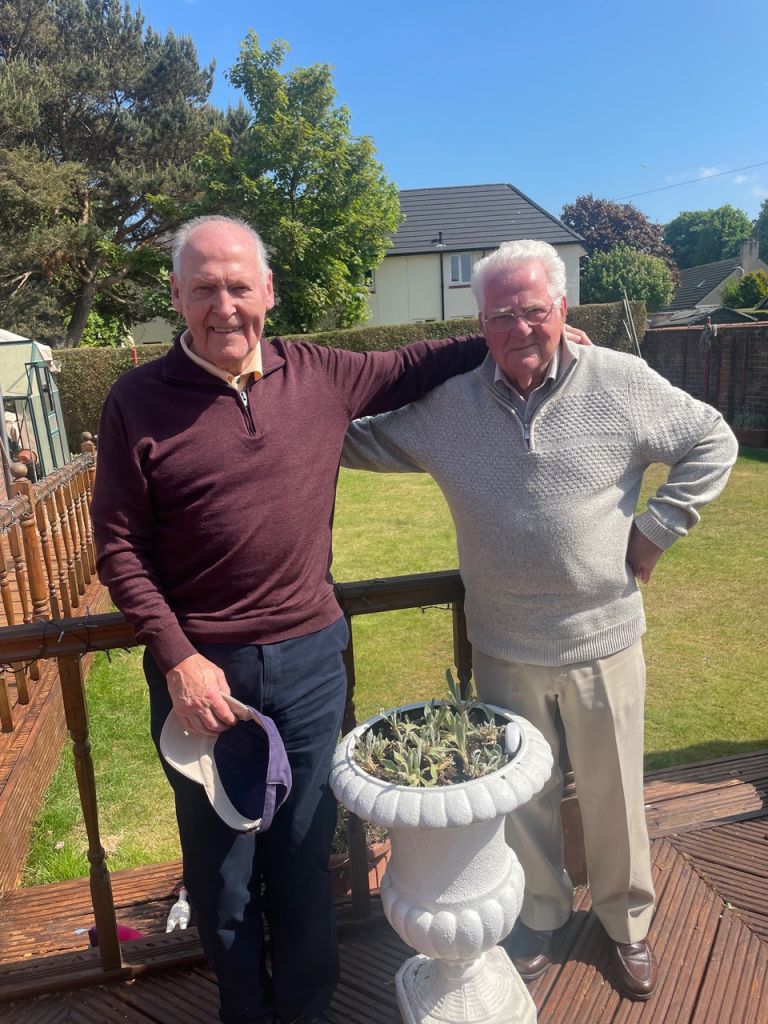
Billy and Peter re-united
As an author, this brings it home to me yet again how important it is that we cherish and share these memories from our club’s past and acknowledge those who created them. Peter and Billy are just two of around 300 Celts who will feature in my forthcoming book on the 1930s, from those who signed for Celtic but perhaps never received a first-team opportunity to the legends we already revere. Those who were part of the backroom team or served on the board.
It will also include those who came into the world during that time, including the first of the Lisbon Lions, or who sadly bade farewell, either as young men in their prime or as older Celts who had played their part in our incredible history many years earlier.
Hopefully, the research I have done, and have still to do, will allow me to include all those who fit into any of the above categories, so that they receive due acknowledgement. If you have any anecdotes relating to a family member or friend who ‘fits the bill’ then by all means let me know and we can take it from there.
Hail, Hail in the meantime and enjoy Hampden in the Sun today!
COYBIG
Matt Corr
